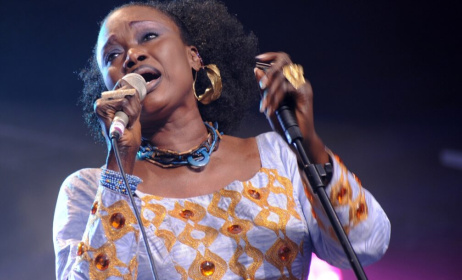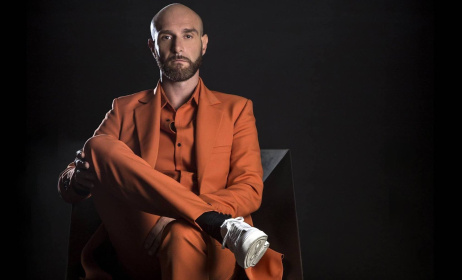The Kitchen Sink Model: A digital strategy for musicians
I was recently asked to deliver a workshop on digital strategies for artists at the 2018 Music In Africa Conference for Collaborations, Exchange and Showcases (ACCES) in Nairobi, Kenya. In terms of guiding East African artists towards good digital strategies, I had wanted to come up with something more ‘big picture’ for a while, rather than a segmented treatment of how to handle Facebook, distribution or marketing as separate entities – to have a model that would help guide an artist to formulate their own useful digital strategies.
 The Kitchen Sink Model illustrated with plastic washing bowls at ACCES 2018.
The Kitchen Sink Model illustrated with plastic washing bowls at ACCES 2018. Fig 1. The pyramid model. Note the colour-coded smaller pyramids within the entire triangular structure.
Fig 1. The pyramid model. Note the colour-coded smaller pyramids within the entire triangular structure.
Like business or content strategies, digital strategies change as an artist grows and as the industry and digital channels evolve, with everything being a variable. So I was quite certain that a ‘model’ would be more useful.
A digital strategy is a strategic plan outlining the specific use of digital channels and online presence to grow an artist's career. There is no one-size-fits-all model, and good strategies need to be updated periodically. The size and quality of an artist's digital footprint can be the difference that separates an artist from the crowd; a model helps an artist to focus on the priorities and to consider the big picture.
This 'pyramid model' is my latest iteration – called the Kitchen Sink Model, not only because washing bowls were what I found in a Nairobi supermarket to build the physical model for the workshop at ACCES 2018, but also because the model looks at everything but the kitchen sink!
It should be noted that this model is made public as a means of industry critique. It is the first of what I plan to be an expanded model (note the red arrows in fig. 1), which will arrange the central variables involved in an established musician's career.
A bottom-up model
The smaller coloured pyramids (fig. 1) each represent a ‘stage’ in the artist's career: 'What is needed?', What works? and 'What outcomes can be expected?' The foundation stone is ‘identity’, which asks questions such as 'Who am I?', 'What do I bring to the table?' and 'What am I saying?' Income can only be expected after all five foundational steps are completed and some targeted outreach has been done.
For many musicians in East Africa, this debunks local beliefs that money will come if there is a musical product. The reality is that it takes a lot more than that. I hope the model will help artists deliver on goals and encourage less time wasting on just pushing socials (although that is still very important). The aim is for artists to work towards getting proper foundations in place that will facilitate the monetisation of their products. This model is based on experiential knowledge collected from emerging artists in the East African music industry, and is suitable for use by artists who want to reach a level of sustainable income from their music career.
The details
The reasoning behind this model is to provide sequencing and guidance about the work musicians/artists needs to do in order to grow their digital footprint (online presence) to a size that facilitates and supports income generation. The model works from the foundation of 'identity' at the bottom. Each colourway represents a developmental stage of the digital footprint. In theory, that should help artists determine the next steps and strategies for growth.
The small red pyramid at the bottom left is the starting point. If an artist has an identity and product, then that signals the time to open social channels and let people know of their presence. But the model shows that it's far from the time they can expect income and far from what’s needed to put the product out for distribution.
The slightly larger purple-red pyramid describes the point at which the artist begins formalising his/her brand in the industry. This includes creating professional brand assets, such as an electronic press kit (EPK), thinking about communication strategies and being more focused on social media posting to help tell the brand and musical story. At this point, there may or may not be growth in terms of fans, but time spent on this phase helps create brand authenticity, history and depth, which will be of great benefit as the digital footprint grows.
The yellow-purple-red pyramid is the point at which the artist moves towards taking the industry seriously, creating a product of ‘sellable’ quality, writing press releases and thinking in terms of marketing campaigns rather than just ‘dropping’ a track when it is ready. It's key to take note that while this is a professional approach, it does not lead to income just yet. Instead, it leads to growing a fan base and getting engagement from it.
The final ‘whole’ pyramid demonstrates the pieces of the puzzle required to get an artist to the point of earning money from their musical product. With all the parts of the pyramid in place, an artist would likely have a decent-sized digital footprint and have all the brand assets and engagement need to launch a product onto the market. Notice that rights management comes before digital distribution, and is foundational.
The model as a whole should help artists to devise their own strategy, and limit time wasting.
The Kitchen Sink Model: all the parts explained
Identity
Identity is the cornerstone of an artist: who they are, what they bring to the table, what their point of view is, their brand, and their unique selling point. Without understanding this, it becomes difficult to market an artist, know their audience and figure out where their musical products fit in the industry. At the beginning of a career, an identity/brand might change alongside the development of the artist's skills and musical product. Having an identity that is authentic and articulative is a key foundational aspect of the artists’ career path.
Musical product
Musical product might refer to songs, lyrics, compositions, recordings or performances that make up a catalogue of work. These might be stored online or offline. An artist needs to be able to describe the stage of a product's development (quality) and correlate its release only when a supportive digital footprint is available for marketing purposes.
Socials
Social channels, whichever ones are appropriate for the artist's region and target audience, are vital in the successful promotion and distribution of a musical product. These channels will often be Facebook and Instagram, but an artist ought to be aware of where his target audiences hangs out online. It's best that at the beginning of a career an artist goes out looking for his audience rather than expecting the audience to find the artist. As the model suggests, it’s best to open social channels once there is a musical product of some kind and a notion of brand identity.
Brand Assets
An EPK with professional images that align with the brand, a compelling bio (brand story), links to music, links to social channels, contacts, events listing, discography and a video of a live performance if applicable. These assets are key to getting bookings, editorials, interviews, media interest and collaborations. The quality of an artist's brand assets signal to the industry that the artist is serious and professional.
Communication
Methods and styles of communication are essential to building an authentic digital footprint. What is said in an email and how it is said can be just as important as who the email is going out to. Setting up mailing lists for fans, industry players and media, early on in a career, and sending out appropriate regular newsletters are just as useful in growing followers and engagement as effective social media channels. Contacting the right people at the wrong time or in the wrong way can end in a lost lead. Real-world interactions that are off-brand can impact negatively online. Even an informal communication strategy can safeguard and help grow an artist.
Stories
What people engage with online may have been reduced to soundbites but they still love stories. Dropping links, tracks or event posters attain minimal engagement on social channels, unless an artist already has thousands of followers. Changing the way information is delivered and building stories by dropping information over time helps engagement. For most artists, this means letting their audiences in on the journey rather than crafting great words. A video of a rehearsal , a picture on the way to an event, backstage photos – these are things that bring the audience closer the world of the artist.
Monetisable products
In the UK a band might perform for many years before making a record. In East Africa, electronic producers tend to produce many tracks (often shared on SoundCloud), which help them to build significant audiences, before they are ready to formally release a track. It’s become increasingly cheaper and accessible to produce a track for release. But with the barrier to entry being so low, it doesn’t mean that every product ought to be released or that a release will make the artist money. Having a releasable product is stepping into the phase where the artist can start to research when, where and how the release can take place and begin to learn about the processes involved in releasing tracks.
Publicity
Press releases, public/digital/TV appearances and courting the attention of the industry are essential parts of an artist’s digital footprint – they add specific detail and weight to what the world can read about the artist and their musical products. The ‘weight’ comes (if the words are positive) because someone else with credibility is saying (or repeating) them. This kind of content, outside social media, can significantly alter the size of an artist's digital footprint and directly lead to having sufficient third-party links for an artist's Wikipedia entry or for Google to show the artist's profile on the RHS search.
Campaigns
Marketing a product in the commercial world is typically done in a campaign format. A marketing episode has a timeline, specific goals for a target audience and a set of assets or activations. Research says that 60 days is the optimum length of a campaign. This causes a rethink about how to drop a track or an event in order to allow sufficient time before and after. Learning about how to do digital marketing is not as central as planning in terms of timeframes, assets and goals.
Fans/engagement
The interesting thing is that even though there is a monetisable product in this part of the model, all that grows are followers and engagement. Artists often ask, “I have so many fans, they love me, so why don’t I have money?” Having a monetisable product does not mean that an artist is automatically granted entry into the business side of the music business. The final section of the model show why this is the case.
Rights management
Intellectual property (IP) is the big thing in the music industry nowadays. It is key to understand how artists can collect money through the new methods of consuming music, such as streaming. It essentially involves micropayments for the use of an artist's IP, compositions, production, lyrics and performances. Understanding what rights an artist holds and who is to collect these payments, for East African artists, can be a tricky and confusing process. Currently, many artists are looking outside the region for reliable solutions regarding collections. What is important is that relationships with collective management organisations (CMOs) are made in advance of distribution.
Digital distribution
Digital distribution is the process of getting an artist's music out onto local and international music platforms, like Spotify or iTunes, for sales, downloads or streaming. There are many digital distributors out there, and a number of alternative music platforms in Africa that provide a localised offering. An artist needs to look carefully at his audience(s) in order to make the right decisions in delivering a product where it will be most valued. What doesn’t generally come with digital distribution through various platforms is publicity. Getting a track distributed is just a starting point. Getting people to listen or buy a product is a much tougher goal.
Outreach
Once an artist has built an audience on social media, shared a musical product and taken steps to get music onto streaming platforms, there needs to be significant pushing to get plays and sales. This rarely happens passively. Part of understanding how best to do this comes from the data collected from social channel insights and distribution analytics, which help to actively target audiences. It is also important to identify bloggers and influencers who are already speaking to audiences.
Products sales/streams/downloads
Musicians today have multiple revenue streams, many of which might be quite small to begin with. Until that 'one track’ makes it big, an artist needs to ensure that all revenue streams function properly and that the data from those is helping to inform strategic direction. Note: the audience always decides.
Goals/$
Notice that this model makes no mention of managers, social media helpers, record labels, hiring a team or the need to get investors on board. This is a model for artists to use as independents working alone (or as a band) to grow a decent digital footprint. It is also a guide to drive digital strategies that will help grow an artist to becoming a professional in the industry with the potential to earn money from their musical products.
Jude Clark is is a behavioural scientist, digital strategist and photographer based in Nairobi, Kenya. She is a cunsultant and the founder of Joose Digital.





















Commentaires